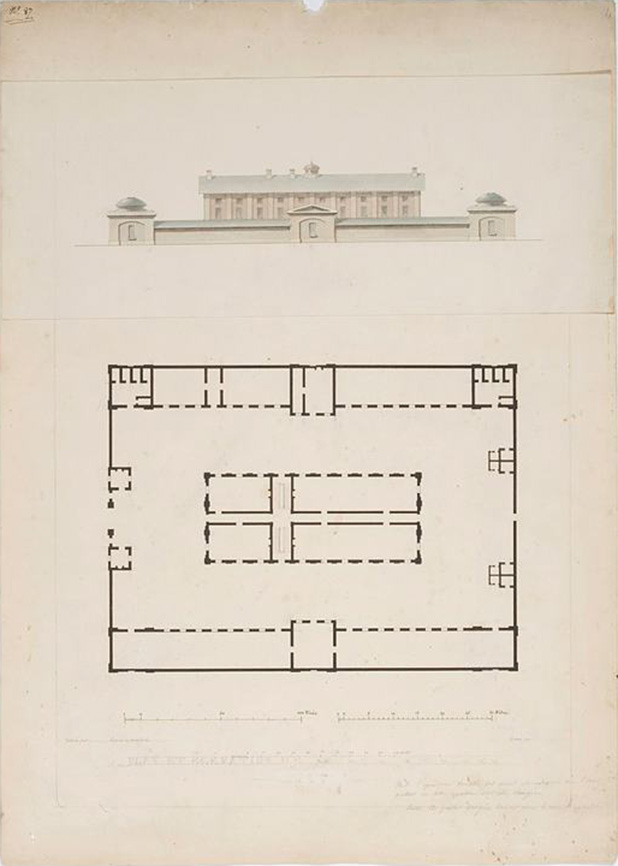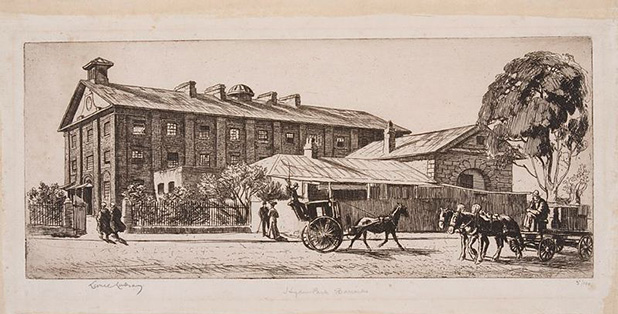Huzza!
June 4, the King’s birthday was a big day in the diary in the Georgian and Regency period. The day traditionally brought a great level of feasting and revelry, even in far-flung Sydney. But there was double celebration on this day in Sydney 1819, when Governor Macquarie presided over the official opening of Hyde Park Barracks, putting on a feast for its new ‘house mates’. Formalities proceeded in the dining or ‘mess’ hall, which formed the southern boundary of the barracks, which were gradually demolished from the 1890s (see images below) . The convicts were treated to a celebratory meal of beef and plum pudding, and ‘a rummer of good punch’ – which was not part of the regular convict allowance, to toast the King. The occasion marked a significant change in convict life in Sydney, affecting convict rights and welfare, health and nutrition (for better or worse in some cases), and a sense general social order in the community, with convict workers off the streets after hours. Commissioner Bigge may not have agreed, but his report was a few years off yet, and whole other story…
Yesterday being the 81st Anniversary of the Birth- Day of Our Venerable and Beloved SOVEREIGN, was observed and commemorated with the wonted demonstrations of loyalty and affectionate regard.
His EXCELLENCY the GOVERNOR visited the Barrack prepared in Hyde Park for the accommodation of male prisoners on Friday, being His Majesty’s Birthday; when, agreeably to previous instructions, the people were to be inspected by His EXCELLENCY in table order. At one o’clock His EXCELLENCY entered the gate, accompanied by HIS LADY, and Master MACQUARIE, this being the dinner hour, when about 600 men were seated at their tables, in the enjoyment of comforts which to the general class of prisoners had been before unknown…
He was pleased in congratulating them upon the auspicious occasion of HIS MAJESTY’S Birthday, on their enjoyment of a house, wherein he trusted, that each person consulting his condition, would find himself better circumstanced than heretofore; their ration being much increased; their comfortable lodging and cloathing amply provided for; and the prospect of favour and indulgence ever in the view of the well behaved…
On His EXCELLENCY’S leaving the dinner rooms, he received three cheers from the grateful people, who all appeared to be happy in their new condition, His EXCELLENCY was accompanied by His Staff, and both the Judges ; all of whom joined His EXCELLENCY in a glass of wine, to the health and future comfort, the well-being, and extension of future favor and indulgence to those whose deserts should entitle them to such benefits. His EXCELLENCY and Family departed at nearly half past one, the people having cheered HIS EXCELLENCY in reiterated peals, finished the dinner of beef and plum pudding, and afterwards had the gratification of drinking in a rummer of good punch to the sanctified remembrance of Our beloved Sovereign.
source: Sydney Gazette and Advertiser, June 5, 1819 via Trove.
Christmas in June?
It’s interesting to note that plum pudding was served as a celebratory dish in 1819, rather than be reserved for Christmas as we would now. At least it was served in the season for which it was originally intended… I can’t imagine the barracks mess hall was a very warm and cosy space… mind you, six hundred men might generate a bit of heat, and the punch might have helped!
And a ‘rummer’?
Rummer is a term for a heavy short-stemmed glass goblet. The word does not have a relationship with rum (except maybe to fill it with) but comes from the German Römer, or Roemer, meaning ‘glass’. It’s highly unlikely that a convict barracks would use glassware, more likely a tin pannikin.

Port Jackson. Plan et Elevation de la Caserne des Convicts, à Sydney by de Louis-Claude Saulces de Freycinet, 1825. Sydney Living Museums HPB2002/6-1
Echoes of the convict mess hall
The convict mess hall formed the southern boundary of the barracks. It had two wings, running to the east and west, which were divided by central kitchens which were manned by a cook and convict staff, who were to ensure that the correct allocation of rations were used and served in fair proprtions to the convicts, and prevent corruption (a somewhat ambitious notion). the mess hall could seat 600 men, in ‘messes’ or groups of six. Each group was issued with an allocated proportion of cooked food, which the men would dole out between them. The building was gradually demolished to accommodate the tramway system from the late 1890s, but you can see it depicted in historic images and architectural drawings.




